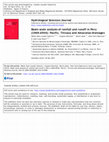Papers by J Carlos A Espinoza

Hydrological Sciences Journal-journal Des Sciences Hydrologiques, 2012
According to the Peruvian agricultural ministry, the Pacific watersheds where the great cities an... more According to the Peruvian agricultural ministry, the Pacific watersheds where the great cities and intense farming are located only benefit from 1% of the available freshwater in Peru. Hence a thorough knowledge of the hydrology of this region is of particular importance. In the paper, analysis of this region and of the two other main Peruvian drainages, the Titicaca and Amazonas are reported. Rainfall and runoff data collected by the Peruvian National Service of Meteorology and Hydrology (SENAMHI) and controlled under the Hydrogeodynamics of the Amazon Basin (HyBAm) project is the basis of this basin-scale study that covers the 1969-2004 period. Beyond the strong contrasting rainfall conditions that differentiate the dry coastal basins and the wet eastern lowlands, details are given about in situ runoff and per basin rainfall distribution in these regions, and about their different altitude-rainfall relationships. Rainfall and runoff variability is strong in the coastal basins at seasonal and interannual time scales, and related to extreme El Niño events in the Pacific Ocean. However, rainfall and runoff are more regular in the Andes and Amazonas at the inter-annual time scale. Warm sea-surface temperatures in the northern tropical Atlantic tend to produce drought in the southern Andes basins. Moreover, significant trends and change-points are observed in the runoff data of Amazonas basins where rainfall and runoff decrease, especially after the mid-1980s and during the low-stage season. Almost all the coastal basins show some change in minimum runoff during the last 35 years while no change is observed in rainfall. This means that human activity may have changed runoff in this region of Peru, but this hypothesis deserves more study.
Uploads
Papers by J Carlos A Espinoza